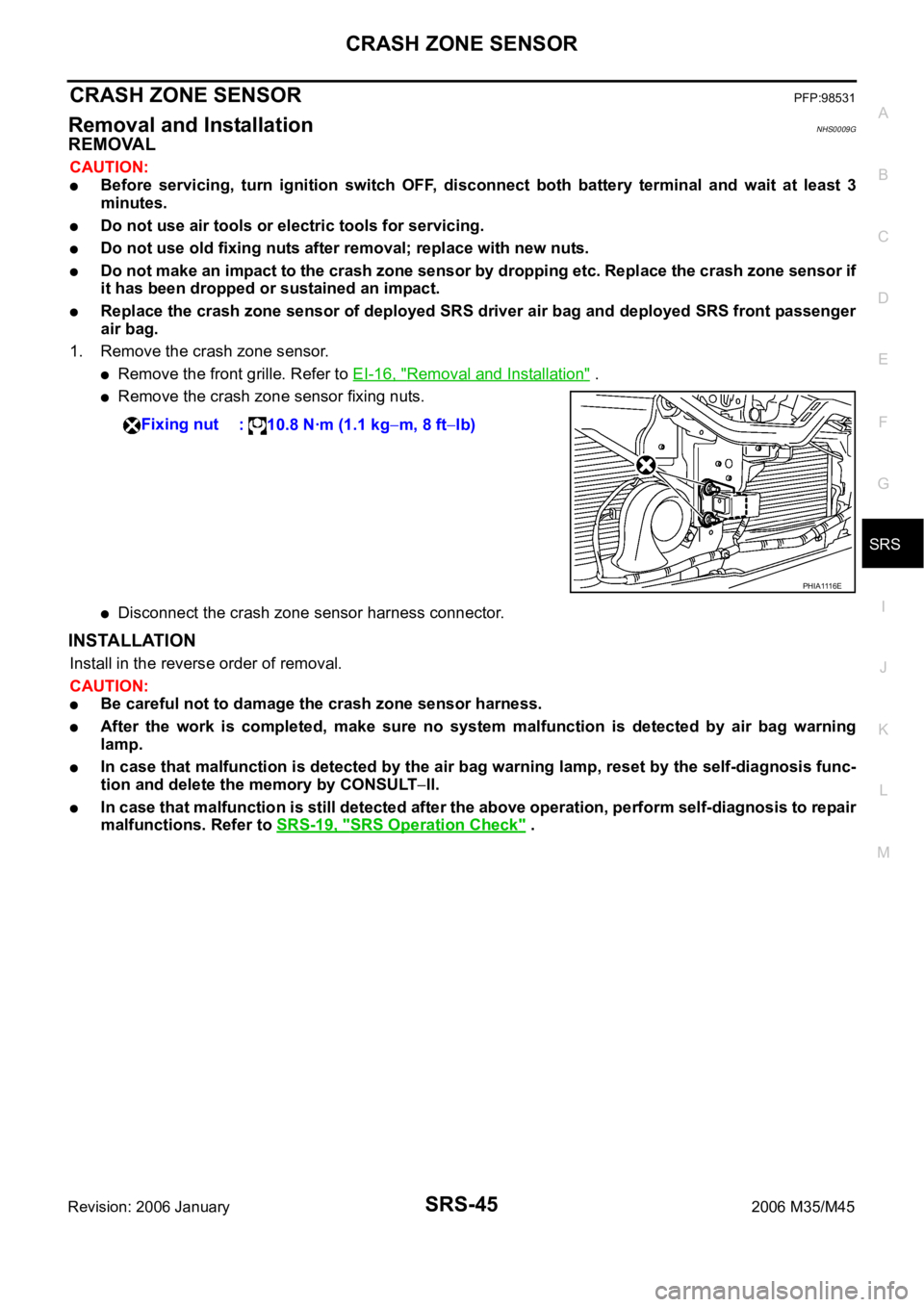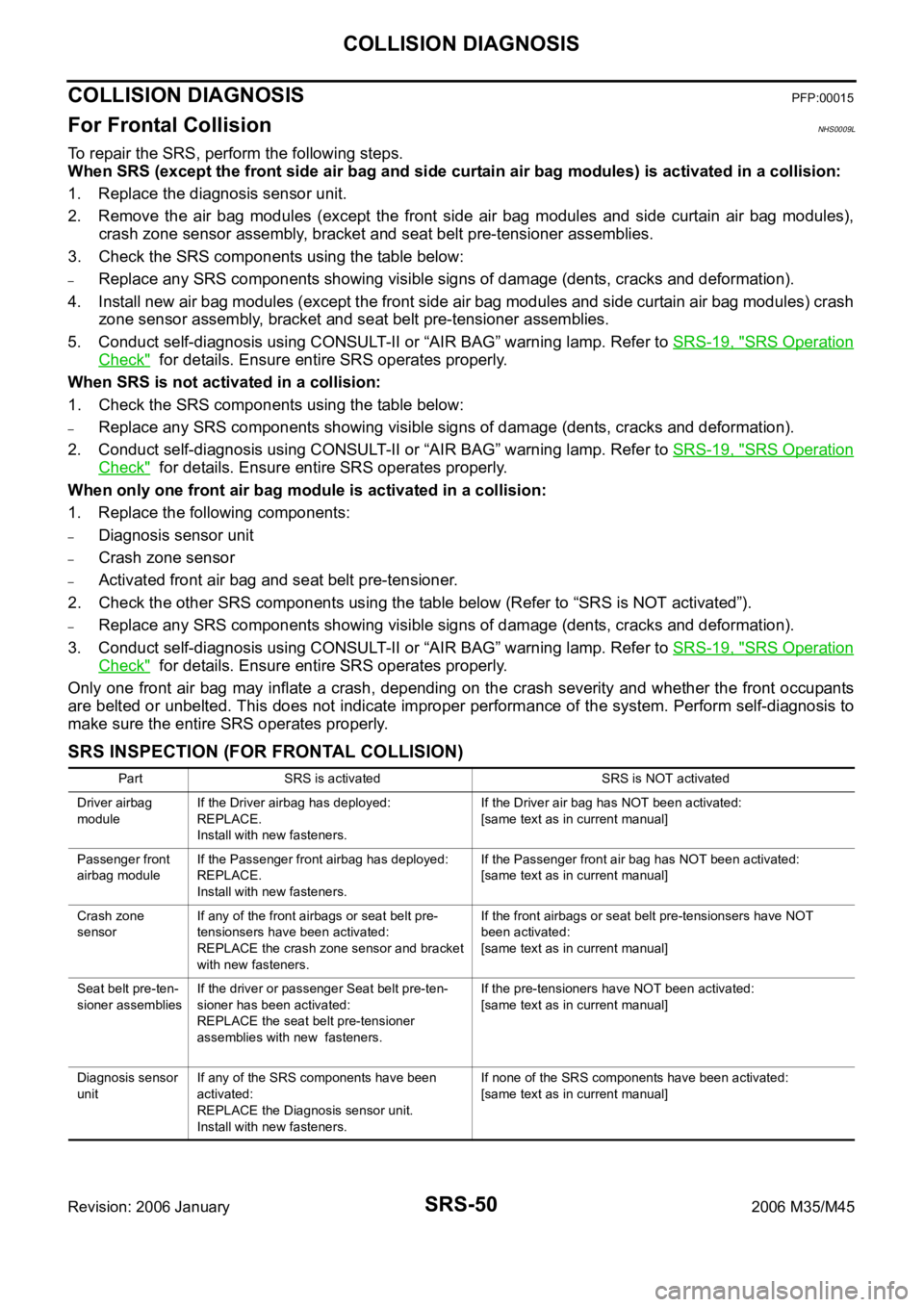2006 INFINITI M35 Ras
[x] Cancel search: RasPage 5406 of 5621

CRASH ZONE SENSOR
SRS-45
C
D
E
F
G
I
J
K
L
MA
B
SRS
Revision: 2006 January2006 M35/M45
CRASH ZONE SENSORPFP:98531
Removal and InstallationNHS0009G
REMOVAL
CAUTION:
Before servicing, turn ignition switch OFF, disconnect both battery terminal and wait at least 3
minutes.
Do not use air tools or electric tools for servicing.
Do not use old fixing nuts after removal; replace with new nuts.
Do not make an impact to the crash zone sensor by dropping etc. Replace the crash zone sensor if
it has been dropped or sustained an impact.
Replace the crash zone sensor of deployed SRS driver air bag and deployed SRS front passenger
air bag.
1. Remove the crash zone sensor.
Remove the front grille. Refer to EI-16, "Removal and Installation" .
Remove the crash zone sensor fixing nuts.
Disconnect the crash zone sensor harness connector.
INSTALLATION
Install in the reverse order of removal.
CAUTION:
Be careful not to damage the crash zone sensor harness.
After the work is completed, make sure no system malfunction is detected by air bag warning
lamp.
In case that malfunction is detected by the air bag warning lamp, reset by the self-diagnosis func-
tion and delete the memory by CONSULT
ll.
In case that malfunction is still detected after the above operation, perform self-diagnosis to repair
malfunctions. Refer to SRS-19, "
SRS Operation Check" . Fixing nut
: 10.8 Nꞏm (1.1 kg
m, 8 ftlb)
PHIA1116E
Page 5411 of 5621

SRS-50
COLLISION DIAGNOSIS
Revision: 2006 January2006 M35/M45
COLLISION DIAGNOSISPFP:00015
For Frontal CollisionNHS0009L
To repair the SRS, perform the following steps.
When SRS (except the front side air bag and side curtain air bag modules) is activated in a collision:
1. Replace the diagnosis sensor unit.
2. Remove the air bag modules (except the front side air bag modules and side curtain air bag modules),
crash zone sensor assembly, bracket and seat belt pre-tensioner assemblies.
3. Check the SRS components using the table below:
–Replace any SRS components showing visible signs of damage (dents, cracks and deformation).
4. Install new air bag modules (except the front side air bag modules and side curtain air bag modules) crash
zone sensor assembly, bracket and seat belt pre-tensioner assemblies.
5. Conduct self-diagnosis using CONSULT-II or “AIR BAG” warning lamp. Refer to SRS-19, "
SRS Operation
Check" for details. Ensure entire SRS operates properly.
When SRS is not activated in a collision:
1. Check the SRS components using the table below:
–Replace any SRS components showing visible signs of damage (dents, cracks and deformation).
2. Conduct self-diagnosis using CONSULT-II or “AIR BAG” warning lamp. Refer to SRS-19, "
SRS Operation
Check" for details. Ensure entire SRS operates properly.
When only one front air bag module is activated in a collision:
1. Replace the following components:
–Diagnosis sensor unit
–Crash zone sensor
–Activated front air bag and seat belt pre-tensioner.
2. Check the other SRS components using the table below (Refer to “SRS is NOT activated”).
–Replace any SRS components showing visible signs of damage (dents, cracks and deformation).
3. Conduct self-diagnosis using CONSULT-II or “AIR BAG” warning lamp. Refer to SRS-19, "
SRS Operation
Check" for details. Ensure entire SRS operates properly.
Only one front air bag may inflate a crash, depending on the crash severity and whether the front occupants
are belted or unbelted. This does not indicate improper performance of the system. Perform self-diagnosis to
make sure the entire SRS operates properly.
SRS INSPECTION (FOR FRONTAL COLLISION)
Part SRS is activated SRS is NOT activated
Driver airbag
moduleIf the Driver airbag has deployed:
REPLACE.
Install with new fasteners.If the Driver air bag has NOT been activated:
[same text as in current manual]
Passenger front
airbag moduleIf the Passenger front airbag has deployed:
REPLACE.
Install with new fasteners.If the Passenger front air bag has NOT been activated:
[same text as in current manual]
Crash zone
sensorIf any of the front airbags or seat belt pre-
tensionsers have been activated:
REPLACE the crash zone sensor and bracket
with new fasteners. If the front airbags or seat belt pre-tensionsers have NOT
been activated:
[same text as in current manual]
Seat belt pre-ten-
sioner assembliesIf the driver or passenger Seat belt pre-ten-
sioner has been activated:
REPLACE the seat belt pre-tensioner
assemblies with new fasteners. If the pre-tensioners have NOT been activated:
[same text as in current manual]
Diagnosis sensor
unitIf any of the SRS components have been
activated:
REPLACE the Diagnosis sensor unit.
Install with new fasteners.If none of the SRS components have been activated:
[same text as in current manual]
Page 5416 of 5621

STC-1
STEERING CONTROL SYSTEM
G STEERING
CONTENTS
C
D
E
F
H
I
J
K
L
M
SECTION STC
A
B
STC
Revision: 2006 January2006 M35/M45
STEERING CONTROL SYSTEM
EPS
SYSTEM DESCRIPTION ............................................ 3
Components ............................................................. 3
Components (Models with Rear Active Steer) ......... 3
Electronically Controlled Power Steering System
Function ................................................................... 3
Fail-Safe Function .................................................... 4
FAIL-SAFE INPUT/CANCEL CONDITIONS ......... 4
TROUBLE DIAGNOSIS .............................................. 5
How to Perform Trouble Diagnosis .......................... 5
BASIC CONCEPT ................................................. 5
Component Parts Location ....................................... 5
Wiring Diagram — EPS — ....................................... 6
Control Unit Input/Output Signal Standard ............... 8
STANDARD BY CIRCUIT TESTER AND OSCIL-
LOSCOPE ........................................................
..... 8
For Fast and Accurate Trouble Diagnosis ................ 9
Basic Inspection ....................................................... 9
POWER SUPPLY CIRCUIT TERMINAL LOOSE-
NESS AND BATTERY .......................................... 9
Inspection: Power Steering Control Unit Power Sup-
ply Circuit and Ground ............................................. 9
Symptom: The Steering Force Does Not Change
Smoothly According to the Vehicle Speed ............. 10
RAS
REAR ACTIVE STEER ............................................. 13
Removal and Installation ........................................ 13
COMPONENTS .................................................. 13
REMOVAL ........................................................
... 13
INSTALLATION ................................................... 13
Disassembly and Assembly ................................... 14
COMPONENTS .................................................. 14
DISASSEMBLY ................................................... 14
INSPECTION AFTER DISASSEMBLY ............... 14
ASSEMBLY ......................................................... 14
Neutral Position Adjustment ................................... 14
SYSTEM DESCRIPTION .......................................... 16
Components ........................................................... 16RAS (Rear Active Steer) Function .......................... 16
Fail-Safe Function .................................................. 17
TROUBLE DIAGNOSIS ............................................ 18
How to Perform Trouble Diagnosis ......................... 18
BASIC CONCEPT ............................................... 18
Component Parts Location ..................................... 19
Schematic ............................................................... 20
Wiring Diagram — RAS — ..................................... 21
Control Unit Input/Output Signal Standard ............. 26
CIRCUIT TESTER REFERENCE VALUE ........... 26
STANDARD BY CONSULT-II .............................. 27
CONSULT-II Function (RAS) .................................. 28
FUNCTION .......................................................
... 28
CONSULT-II SETTING PROCEDURE ................ 28
SELF-DIAG RESULT MODE ............................... 28
DATA MONITOR MODE ...................................... 30
ACTIVE TEST MODE ......................................... 30
RAS CONTROL UNIT PART NUMBER .............. 30
Diagnosis Procedure with Self-Diagnosis Function
(Without CONSULT-II) ............................................ 31
DESCRIPTION .................................................... 31
SELF-DIAGNOSIS PROCEDURE ...................... 31
SELF-DIAGNOSIS DISPLAY .............................. 31
SELF-DIAGNOSIS DISPLAY ITEMS .................. 31
HOW TO ERASE SELF-DIAGNOSIS ................. 31
CAN Communication .............................................. 31
SYSTEM DESCRIPTION .................................... 31
For Fast and Accurate Trouble Diagnosis .............. 32
Basic Inspection ..................................................... 32
BASIC INSPECTION 1: POWER SUPPLY CIR-
CUIT TERMINAL LOOSENESS AND BATTERY ... 32
BASIC INSPECTION 2: RAS WARNING LAMP
INSPECTION ...................................................... 32
BASIC INSPECTION 3: RAS CONTROL UNIT
POWER SUPPLY CIRCUIT AND GROUND CIR-
CUIT INSPECTION ............................................. 32
Trouble Diagnosis Chart ......................................... 33
SELF-DIAGNOSIS .............................................. 33
DIAGNOSIS CHART BY SYMPTOM .................. 34
Inspection 1: RAS Control Unit Malfunction ........... 35
Page 5417 of 5621

STC-2Revision: 2006 January2006 M35/M45 Inspection 2: Motor Power Supply System ............. 35
Inspection 3: RAS Motor Output Malfunction ......... 37
Inspection 4: Vehicle Speed Signal ........................ 38
Inspection 5: Steering Angle Signal Malfunction .... 38
Inspection 6: Rear Main Signal and Rear Sub Signal
Malfunction ............................................................. 40
Inspection 7: VDC Malfunction ............................... 42
Inspection 8: Engine Speed Signal Malfunction ..... 43
Inspection 9: CAN Communication System Mal-
function ................................................................... 43Inspection 10: Stop Lamp Switch Harness ............. 44
Inspection 11: RAS Warning Lamp Harness ........... 44
Diagnosis Chart by Symptom 1 .............................. 46
Diagnosis Chart by Symptom 2 .............................. 46
Check RAS Static/Dynamic Characteristics ............ 48
Component Parts Inspection ................................... 49
RAS MOTOR RELAY ........................................... 49
RAS MOTOR ....................................................... 49
REAR WHEEL STEERING ANGLE SENSOR .... 49
Page 5418 of 5621
![INFINITI M35 2006 Factory Service Manual SYSTEM DESCRIPTION
STC-3
[EPS]
C
D
E
F
H
I
J
K
L
MA
B
STC
Revision: 2006 January2006 M35/M45
[EPS]SYSTEM DESCRIPTIONPFP:00000
ComponentsNGS000DT
Components (Models with Rear Active Steer)NGS000DU
Elec INFINITI M35 2006 Factory Service Manual SYSTEM DESCRIPTION
STC-3
[EPS]
C
D
E
F
H
I
J
K
L
MA
B
STC
Revision: 2006 January2006 M35/M45
[EPS]SYSTEM DESCRIPTIONPFP:00000
ComponentsNGS000DT
Components (Models with Rear Active Steer)NGS000DU
Elec](/manual-img/42/57023/w960_57023-5417.png)
SYSTEM DESCRIPTION
STC-3
[EPS]
C
D
E
F
H
I
J
K
L
MA
B
STC
Revision: 2006 January2006 M35/M45
[EPS]SYSTEM DESCRIPTIONPFP:00000
ComponentsNGS000DT
Components (Models with Rear Active Steer)NGS000DU
Electronically Controlled Power Steering System FunctionNGS000DV
Vehicle speed sensing electronically controlled power steering
(that properly controls the steering force by the vehicle speed)
has been adopted. When it is normal, it controls the power
steering solenoid valve according to the vehicle speed as shown
in the figure and makes the steering force proper.
For the models with RAS (Rear Active Steer), RAS control unit
performs the same control as power steering control unit. For
schematic, refer to STC-20, "
Schematic" and trouble diagnosis,
refer to STC-46, "
Diagnosis Chart by Symptom 2" .
SGIA1056E
SGIA1094E
SST696CA
Page 5428 of 5621
![INFINITI M35 2006 Factory Service Manual REAR ACTIVE STEER
STC-13
[RAS]
C
D
E
F
H
I
J
K
L
MA
B
STC
Revision: 2006 January2006 M35/M45
[RAS]REAR ACTIVE STEERPFP:55705
Removal and InstallationNGS000E5
COMPONENTS
REMOVAL
1. Remove coil spring. INFINITI M35 2006 Factory Service Manual REAR ACTIVE STEER
STC-13
[RAS]
C
D
E
F
H
I
J
K
L
MA
B
STC
Revision: 2006 January2006 M35/M45
[RAS]REAR ACTIVE STEERPFP:55705
Removal and InstallationNGS000E5
COMPONENTS
REMOVAL
1. Remove coil spring.](/manual-img/42/57023/w960_57023-5427.png)
REAR ACTIVE STEER
STC-13
[RAS]
C
D
E
F
H
I
J
K
L
MA
B
STC
Revision: 2006 January2006 M35/M45
[RAS]REAR ACTIVE STEERPFP:55705
Removal and InstallationNGS000E5
COMPONENTS
REMOVAL
1. Remove coil spring. Refer to RSU-16, "REAR LOWER LINK & COIL SPRING" .
2. Disconnect harness connector from RAS actuator assembly and rear suspension member.
3. Remove fixing bolts and nuts of RAS actuator assembly (1), and
then remove RAS actuator assembly (1) from rear suspension
member.
INSTALLATION
Installation is the reverse order of removal. For tightening torque, refer to STC-13, "COMPONENTS" .
When installing RAS actuator assembly to rear suspension member, check the mounting surfaces of RAS
actuator assembly and rear suspension member for oil, dirt, sand, or other foreign materials.
To perform the neutral position adjustment. Refer to STC-14, "Neutral Position Adjustment" .
1. Rear lower link 2. Decenter cam 3. RAS actuator assembly
Refer to GI-11, "
Components" , for the symbols in the figure.
SGIA1238E
SGIA1239E
Page 5429 of 5621
![INFINITI M35 2006 Factory Service Manual STC-14
[RAS]
REAR ACTIVE STEER
Revision: 2006 January2006 M35/M45
Disassembly and AssemblyNGS000E6
COMPONENTS
DISASSEMBLY
1. Remove mounting bolts of RAS motor assembly, and then remove RAS motor asse INFINITI M35 2006 Factory Service Manual STC-14
[RAS]
REAR ACTIVE STEER
Revision: 2006 January2006 M35/M45
Disassembly and AssemblyNGS000E6
COMPONENTS
DISASSEMBLY
1. Remove mounting bolts of RAS motor assembly, and then remove RAS motor asse](/manual-img/42/57023/w960_57023-5428.png)
STC-14
[RAS]
REAR ACTIVE STEER
Revision: 2006 January2006 M35/M45
Disassembly and AssemblyNGS000E6
COMPONENTS
DISASSEMBLY
1. Remove mounting bolts of RAS motor assembly, and then remove RAS motor assembly, ground terminal,
O-ring from RAS actuator.
2. Remove mounting bolt of rear wheel steering angle sensor, and then remove rear wheel steering angle
sensor, O-ring from RAS actuator.
INSPECTION AFTER DISASSEMBLY
Check RAS actuator bracket (rear wheel steering angle sensor mounting area) for crush, deformation, cracks,
or other damage. Replace the RAS actuator malfunction is detected.
ASSEMBLY
Assembly is the reverse order of disassembly. For tightening torque, refer to STC-14, "COMPONENTS" .
After assembling RAS actuator assembly (after removing and installing rear wheel angle sensor and RAS
motor), perform the neutral position adjustment.
Neutral Position AdjustmentNGS000E7
Adjust neutral position after performing the following procedure.
Removing and installing or replacing the RAS actuator assembly
Disassembling the RAS actuator assembly (when removing rear wheel steering angle sensor and RAS
motor)
CAUTION:
Perform the neutral position adjustment after installing the RAS actuator assembly to the vehicle.
Before that, remove the rear lower link from the RAS actuator.
1. Disconnect harness connector and remove rear wheel steering angle sensor from the RAS actuator
assembly.
2. Disconnect RAS motor harness connector.
3. Turn ignition switch ON.
1. Ground terminal 2. RAS motor assembly 3. O-ring
4. RAS actuator 5. Rear wheel steering angle sensor
Refer to GI-11, "
Components" , for the symbols in the figure.
SGIA1052J
Page 5430 of 5621
![INFINITI M35 2006 Factory Service Manual REAR ACTIVE STEER
STC-15
[RAS]
C
D
E
F
H
I
J
K
L
MA
B
STC
Revision: 2006 January2006 M35/M45
4. Supply 6 V voltage by connecting the four 1.5 V batteries in a
series. Connect them to the RAS motor con INFINITI M35 2006 Factory Service Manual REAR ACTIVE STEER
STC-15
[RAS]
C
D
E
F
H
I
J
K
L
MA
B
STC
Revision: 2006 January2006 M35/M45
4. Supply 6 V voltage by connecting the four 1.5 V batteries in a
series. Connect them to the RAS motor con](/manual-img/42/57023/w960_57023-5429.png)
REAR ACTIVE STEER
STC-15
[RAS]
C
D
E
F
H
I
J
K
L
MA
B
STC
Revision: 2006 January2006 M35/M45
4. Supply 6 V voltage by connecting the four 1.5 V batteries in a
series. Connect them to the RAS motor connector (motor side),
and then operate the motor and adjust the rack in the neutral
position (A).
CAUTION:
Do not supply 12 V voltage (battery, etc) to the RAS motor.
NOTE:
For right stroke, connect positive probe to the RAS motor con-
nector terminal 1. For left stroke, connect it to the terminal 2.
5. Install rear wheel steering angle sensor with O-ring to the RAS
actuator assembly. Temporarily tighten the mounting bolts in the specified torque that the sensor can be
moved by hand.
6. Turn and adjust the rear wheel steering angle sensor so as to make each sensor signal of “DATA MONI-
TOR” mode to the following standard with CONSULT-II.
CAUTION:
During DATA MONITOR mode, “MONITORING ERROR” is displayed. But there is not malfunction
in this procedure.
7. Tighten rear wheel steering angle sensor mounting bolts.
8. Perform “ERASE” with CONSULT-II, and then erase the error memory of rear wheel steering angle sen-
sor. Refer to STC-29, "
How to Erase Self-Diagnostic Results" .
9. Perform CONSULT-II “SELF-DIAG RESULTS” again, and then make sure that there is no malfunction.
Refer to STC-28, "
SELF-DIAG RESULT MODE" . Full stroke (B) : 6.8 - 7.2 mm (0.268 - 0.283 in)
STEERING ANG () L - 0, R - 0, N - 0
RR ST ANG-MAI (V) Approx. 2.4
RR ST ANG-SUB (V) Approx. 2.4
RR ST ANG-VOL (V) Approx. 5.0
SGIA1240E